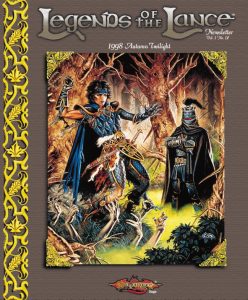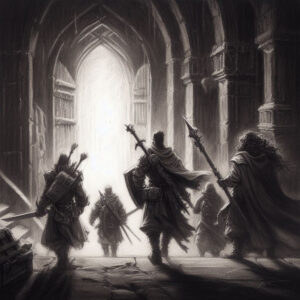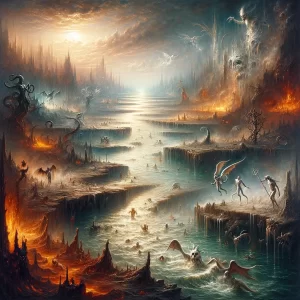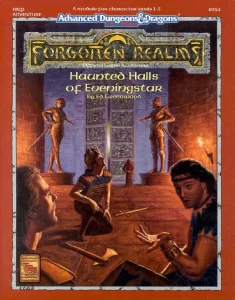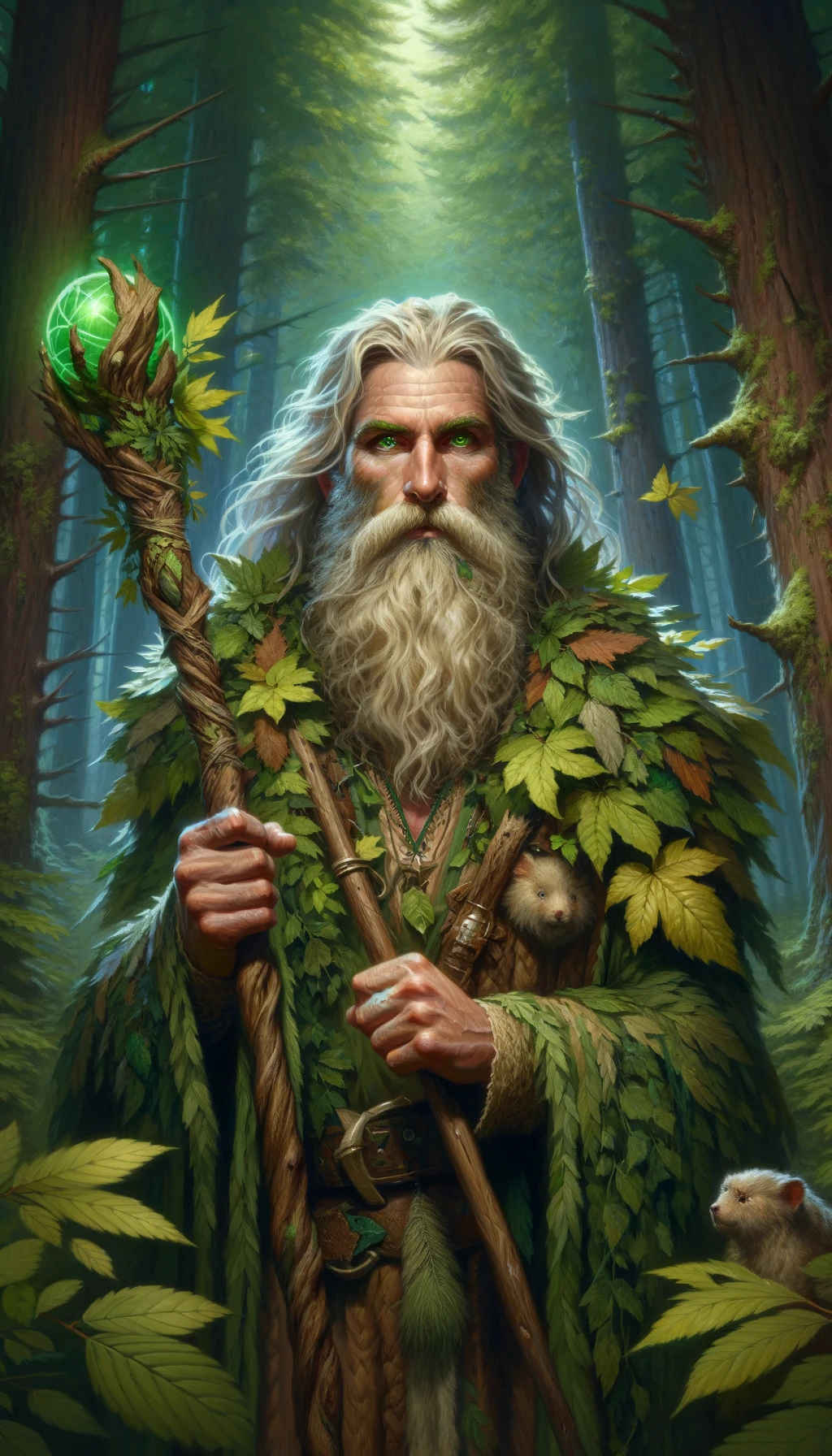
With a staff twisted and gnarled as the ancient roots of a Treant, wreathed with holly that whispers of winter's embrace, an elf druid stands as a silhouette against the stormy horizon. Drawing upon her innate connection to the Storm Domain, she summons explosive bolts of lightning, casting Call Lightning, a spell that sends wrathful serpents of energy smiting the torch-carrying orc raiders who threaten the verdant tranquility of her sacred grove.
High above, concealed on a towering branch and taking the graceful form of a leopard through Wild Shape, a human Ranger scouts the jungle. His focus is on the eerie, rune-covered construction of a temple dedicated to the Evil Elemental Air, a nod to the nefarious Cult of the Howling Hatred. With every sense heightened, he keeps a vigilant watch on the cultists' mysterious activities, the silence of the wilderness his only ally.
Armed with a blade that blazes with the ethereal fire of the Flame Tongue sword, a half-elf Paladin charges with the grace of a celestial warrior into a mass of skeletal warriors. His aura, bright as a star's core, illuminates the cursed darkness that clings to the ancient battlefield. With each swing, he casts Divine Smite, his blade not just a weapon but a beacon of sacred wrath. The air crackles with celestial energy as each strike cleaves through the dark magic animating these foul creatures, the blade singing a resounding hymn against the abomination of undeath.
As bone shards scatter like malevolent confetti, the Paladin's relentless advance becomes a dance of destruction. Each move is both precise and powerful, as if choreographed by the divine themselves. The skeletons, with their eerie, clattering sounds, seem almost to hesitate, as if the very fire that engulfs them whispers warnings of their imminent return to dust. Amidst the chaos, the Paladin's eyes burn with a fierce determination, a clear testament to his unyielding faith and the righteousness of his cause.
He moves like a storm, unstoppable and fierce, his convictions as sharp as his sword. With every fallen enemy, the light around him grows stronger, pulsing in harmony with his heartbeat-a steady drum of war against the darkness. As the last of the skeletal horde crumbles to the ground, the silence that follows seems to roar in approval, the battlefield sanctified once more by his valorous deeds. The Paladin, standing amidst the remnants of corruption, raises his sword in a solemn salute to the sky, acknowledging the divine power that flows through him, ever ready to strike down evil wherever it may rise.
In such feats and countless more, druids stand as embodiments of nature's profound resilience, cunning, and unchecked fury. They are not masters of the untamed wild but rather see themselves as humble extensions of nature's indomitable, ever-present will.
Above all else, druids revere the essence of nature, drawing their spells and magical abilities either from the pulsing heart of the wilderness itself or from the embrace of a nature deity. Deeply attuned to the ebb and flow of natural energies, they can sense the whispers of the earth, the murmurs of trees, and the silent pleadings of stones. Many walk a mystic path of transcendent union with the natural world, eschewing the worship of divine entities for a more profound, direct communion with the forces of nature. Others dedicate themselves to gods of wild nature, animals, or elemental forces, forming bonds with deities who embody the fierce independence and untamed power of the natural world.
These ancient practices, sometimes referred to as the Old Faith, stand in stark contrast to the structured worship found in temples and shrines. While clerics and priests might read from sacred texts and perform ritualized prayers within the confines of ornate buildings, druids experience their liturgies beneath the open skies, guided by the rustling of leaves and the patterns of the stars. Their rituals are spontaneous and organic, marked by the cycles of the moon, the changing seasons, and the migrations of animals. They celebrate the rites of spring with the blossoming of flowers, honor the sun at its zenith during the summer, give thanks during the autumn harvest, and chant to the quiet of the winter snows.
In their reverence for nature, druids often become guardians of sacred groves, ancient forests, tranquil glades, and vibrant ecosystems, ensuring that these places remain untouched by the ravages of civilization. They view themselves as part of a larger cycle, a thread in an eternal weave, where every leaf, every creature, and every drop of water is integral to the whole. Through their deep-rooted connections, they gain not only the power to heal and rejuvenate but also the might to unleash nature's wrath against those who would desecrate its sanctity.
Their spirituality is one of action and presence, a constant interaction with the living world that surrounds them. Each decision, each ritual, each moment of their lives is an expression of their devotion, creating a living testament to their faith in the natural order. This profound connection fosters a unique kinship with all living things, making druids among the most formidable advocates for the environment and its myriad inhabitants.
Their spellcasting echoes the primal rhythms of nature-manifesting the power of tooth and claw, sun and moon, fire and storm. Embracing their wild connection, druids often gain the ability to assume the forms of animals, a practice some perfect to the point of preferring the purity of an animal's shape to their own.
Druids see the world in a delicate, harmonious balance where air, earth, fire, and water-the fundamental building blocks of existence-must coexist in equilibrium. Their understanding of these elements goes beyond mere respect; it is a deep, intrinsic recognition of their interdependence, a philosophy that sees all life as interconnected through these primal forces. Should one element overpower the others, the world might crumble, drawn into one of the elemental planes, shattering into its constituent parts. Such catastrophic shifts can lead to devastating consequences, from droughts and floods to wildfires and storms, all signs that the delicate balance has been disturbed.
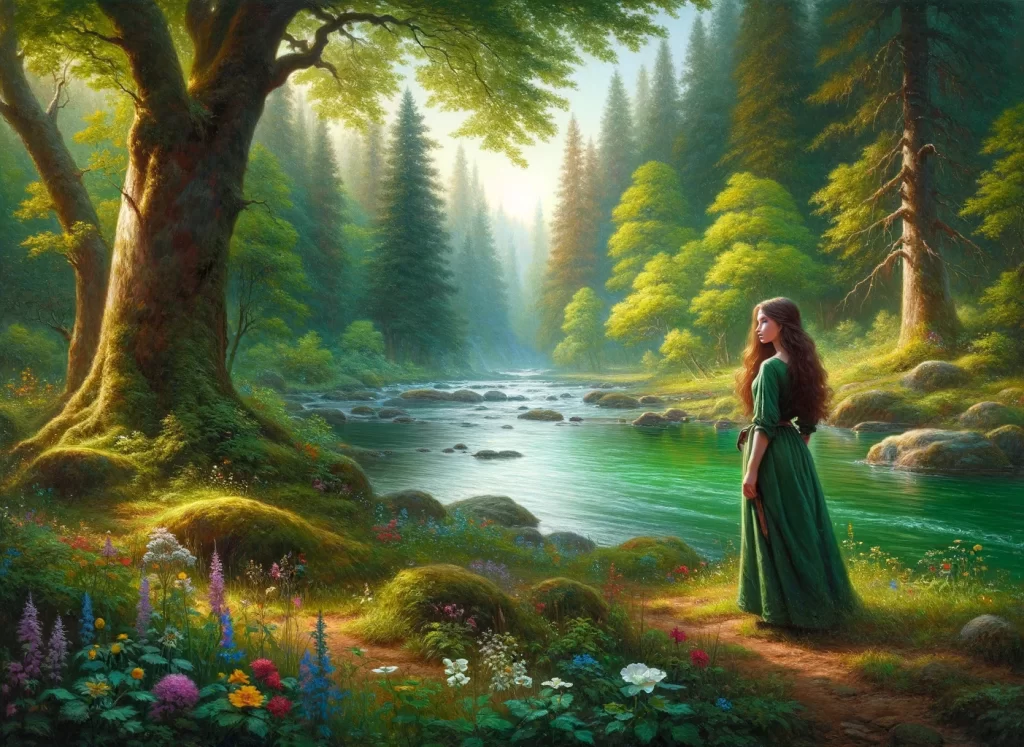
Thus, druids stand as vigilant guardians against forces like the cults of Elemental Evil, who would disrupt this balance. These malevolent groups seek to elevate one element above all, sowing discord and wielding elemental power for destruction and chaos. Druids, with their profound connection to the natural order, are uniquely equipped to counteract these threats. They employ their deep knowledge of natural lore, casting spells that restore equilibrium or summoning elemental beings to aid in their quest to maintain or restore balance.
Their role as mediators extends beyond combating overt threats; they also work tirelessly to heal lands that have suffered from natural disasters or human exploitation. By performing sacred rites and channeling the intrinsic energy of their surroundings, druids can rejuvenate soil, purify water sources, and regrow forests, gradually restoring the natural balance that supports all life.
Moreover, druids often act as counselors to local communities, teaching sustainable practices and promoting a lifestyle that respects and nurtures the environment. They encourage agricultural methods that enhance soil fertility without depleting it and advocate for living in a way that minimizes harm to the ecosystems that surround and support human settlements.
In all these ways, druids do more than just protect the physical environment-they preserve the metaphysical essence that binds the material world, ensuring that the tapestry of life, woven from strands of earth, air, fire, and water, remains intact and vibrant for generations to come. Their vigilance and deep connection to the elements make them indispensable stewards of the world, ever committed to the preservation and flourishing of nature's harmonious balance.
Often seen as solemn watchers over pristine wilderness or sacred sites, druids become formidable defenders when threats arise, jeopardizing nature's equilibrium or the sanctity of the lands they hold dear. In these times, they rise as adventurers, their hearts bolstered by courage.
Sacred to a druid are certain plants like alder, ash, birch, and others-each not merely vegetation but conduits for their spells and crafting materials for their magical staffs and shields. Even in lands devoid of these familiar plants, druids commune with local flora, adapting their practices to embrace the uniqueness of each ecosystem.
As they stand as caretakers of the world's natural beauty, druids slowly become the very voice of nature itself, a whisper in the wind, a murmur in the brook. They transform into living conduits of the earth's mystery and power, their souls entwined with the ancient rhythms of the land, reminding all of the deep, primal connection between life and the land, a connection that sings in every leaf and echoes in every heartbeat of the world.


